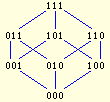Isoperimetric Tools
Solution of the MWI/MRI problem
Let P be a ranked poset with a weight function w : P -> R.
For a subset A of P denote by w(A) the sum of weights
of elements of A. The subset A is called ideal if for
every element x of A all elements preceeding x in the
partial order are in A. It is easily seen that for every
m = 1 . . |P| there exists an ideal of size m.
The Maximum Weight Ideal (MWI) problem consists of finding for a
given m an ideal A of P such that |A| = m and
w(A) is maximum among all ideals of size m. This maximum value
of the weight is denoted by w(m).
The Maximum Rank Ideal (MRI) problem is a special case of the MWI
problem with the weight function being equal to the poset rank function.
Both problems have numerous applications to extremal poset problems [3],
to edge-isoperimetric problems of graphs [2], and to many other
optimization problems on graphs and posets.
The MWI and MRI problems are NP-complete, so there is no much hope for an
efficient solution of them. The program is based on an algorithm from [1]
for generating all ideals in a poset. Furthermore, the program checks
whether or not the poset admits nested solutions. If nested solutions
exist, one of optimal total orders is computed.
Otherwise, a longest initial series of nested solutions is output.
Important:
- To solve the MRI problem, your poset must be encoded as a
non-weight one and must be ranked by the nature of the problem. In this case
make sure to uncheck the "weighed" box in the uploading dialog.
- To solve the MWI problem, your poset must be encoded as a weighted
one and must be ranked for the current version of the tool. Make sure to
check the "weighed" box in the poset uploading dialog.
References
[1] X. Berenguer, L.H. Harper: Estabilizacion y resolucion de algunos
problemas combinatorios en grafos simetricos, Questio, vol. 3 (1979),
No. 2, 105-117.
[2] S.L. Bezrukov: On an equivalence in
discrete extremal problems, Discr. Math., vol. 203, 1999, no. 1, 9-22.
[3] K. Engel: Sperner theory, Cambridge University Press, 1997.
Select a file to upload
Poset encoding instructions
Encoding of non-weighted posets
The poset file is a text (ASCII) file with the number of lines equal to the
number of poset elements, that is one line per element. For each element
p of P the corresponding line must contain the following information on
p:
label
label1 label2 . . .
labelk
Here:
label is the label of p
(a string consisting of letters, digits or underscore only)
label1 label2 . . .
labelk is a list of labels of vertices covered
by p. If p covers no other vertex, this list is empty.
Moreover, the file must satisfy the following claims:
- The file size must not exceed 50 kilobytes.
- The parameters within one line must be separated by one or more spaces.
- Empty lines are ignored.
- A portion of a line followed by the # sign is considered as a comment
and ignored. The comments are optional.
Example
| Poset | Encoding | Comments |
|---|
 |
000 # the bottom vertex
001 000 # first level
010 000
100 000
011 001 010 # second level
101 001 100
110 010 100
111 011 101 110 # the top level
|
000 is the label
empty line, ignored
vertex 001 covers 000
vertex 010 covers 000
vertex 100 covers 000
vertex 011 covers 001 and 010
vertex 101 covers 001 and 100
vertex 110 covers 010 and 100
the top vertex covering 3 other vertices
|
Check Gallery of Posets for more examples.
Encoding of weighted posets
The encoding in this case is similar to the one above. The only difference
is that every line of text must contain information on the weight of the
corresponsing poset element.
The poset file is a text (ASCII) file with the number of lines equal to the
number of poset elements, that is one line per element. For each element
p of P the corresponding line must contain the following information on p:
label
weight
label1 label2 . . .
labelk
Here:
label is the label of p
(a string consisting of letters, digits or underscore only)
weight is the weight of p
(an integer number, negative numbers are supported)
label1 label2 . . .
labelk is a list of labels of vertices covered
by p. If p covers no other vertex, this list is empty.
Moreover, the file must satisfy the following claims:
- The file size must not exceed 50 kilobytes.
- The parameters within one line must be separated by one or more spaces.
- Empty lines are ignored.
- A portion of a line followed by the # sign is considered as a comment
and ignored. The comments are optional.
Example
| Poset | Encoding | Comments |
|---|
 |
000 1 # the bottom vertex
001 1 000 # first level
010 2 000
100 -1 000
011 3 001 010 # second level
101 3 001 100
110 2 010 100
111 1 011 101 110 # the top level
|
000 is the label, 1 is the weight
empty line, ignored
vertex 001 covers 000
vertex 010 covers 000
vertex 100 covers 000 and has negative weight
vertex 011 covers 001 and 010
vertex 101 covers 001 and 100
vertex 110 covers 010 and 100
the top vertex covering 3 other vertices
|
Last modified:
Mon, Jan 23, 2023.
